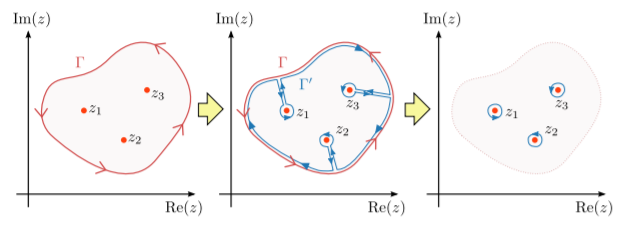9.2: Cauchy's Integral Theorem
( \newcommand{\kernel}{\mathrm{null}\,}\)
A loop integral is a contour integral taken over a loop in the complex plane; i.e., with the same starting and ending point. In Section 9.1, we encountered the case of a circular loop integral. More generally, however, loop contours do not be circular but can have other shapes.
Loop integrals play an important role in complex analysis. This importance stems from the following property, known as Cauchy’s integral theorem:
Theorem 9.2.1
If f(z) is analytic everywhere inside a loop Γ, then ∮Γdzf(z)=0.
Proof of Cauchy’s integral theorem
Cauchy’s integral theorem can be derived from Stokes’ theorem, which states that for any differentiable vector field →A(x,y,z) defined within a three-dimensional space, its line integral around a loop Γ is equal to the flux of its curl through any surface enclosed by the loop. Mathematically, this is stated as ∮Γ→dℓ⋅→A=∫S(Γ)d2rˆn⋅(∇×→A),
We only need the 2D version of Stokes’ theorem, in which both the loop Γ and the enclosed surface S(Γ) are restricted to the x−y plane, and →A(x,y) likewise has no z component. Then Stokes’ theorem simplifies to ∮Γ→dℓ⋅→A=∫∫S(Γ)dxdy(∂Ay∂x−∂Ax∂y).
Now consider a loop integral ∮Γdzf(z),
Consequences of Cauchy’s integral theorem
If the integrand f(z) is non-analytic somewhere inside the loop, Cauchy’s integral theorem does not apply, and the loop integral need not vanish. In particular, suppose f(z) vanishes at one or more discrete points inside the loop, {z1,z2,…}. Then we can show that ∮Γdzf(z)=∑n∮zndzf(z),
The proof of this result is based on the figure below. The red loop, Γ, is the contour we want to integrate over. The integrand is analytic throughout the enclosed area except at several discrete points, say {z1,z2,z3}.

Let us define a new loop contour, Γ′, shown by the blue loop. It follows the same curve as Γ but with the following differences: (i) it circles in the opposite direction from Γ, (ii) it contains tendrils that extend from the outer curve to each point of non-analyticity, and (iii) each tendril is attached to an infinitesimal loop encircling a point of non-analyticity.
The loop Γ′ encloses no points of non-analyticity, so Cauchy’s integral theorem says that the integral over it is zero. But the contour integral over Γ′ can be broken up into three pieces: (i) the part that follows Γ but in the opposite direction, (ii) the tendrils, and (iii) the infinitesimal inner loops: ∮Γ′dzf(z)=0(byCauchy′sIntegralTheorem)=∫bigloopdzf(z)+∫tendrilsdzf(z)+∑small loop n∮zndzf(z)
Another way of thinking about this is that Cauchy’s integral theorem says regions of analyticity don’t count towards the value of a loop integral. Hence, we can contract a loop across any domain in which f(z) is analytic, until the contour becomes as small as possible. This contraction replaces Γ with a discrete set of infinitesimal loops enclosing the points of non-analyticity.


